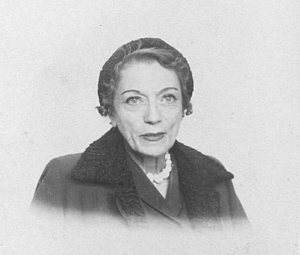Thyra Samter Winslow
Thyra Samter Winslow attended the University of Missouri School of Journalism and later moved to Chicago, where she worked as a chorus girl, actor, and dancer. Winslow then worked as a feature writer with the Chicago Tribune and began publishing stories and articles for newspapers and magazines such as The Smart Set and American Mercury. She briefly attended Columbia University and the Cincinnati Art Academy, but her career as a fiction writer blossomed in the 1930s when she began to publish stories in The New Yorker. In 1937, Winslow began working as a screenwriter with Columbia, RKO, Warner Brothers, and NBC. Winslow’s writing often depicts complicated images of womanhood: while she glamorizes marriage as a means to happiness, many of her female characters harbor feelings of anger, boredom, and oppression, and even thoughts of suicide.
Overview and Writing Career
Author Thyra Samter Winslow’s sketches of women’s lives reflect her combined feelings of fondness for and restless impatience with small-town life, and later her attraction to the big city.
Born to Louis and Sara (Harris) Samter on March 15, 1893, she began writing as a child, and, like many of her young female characters, she yearned for life beyond her hometown of Fort Smith, Arkansas. She eventually left to attend the University of Missouri School of Journalism and later moved to Chicago, where she worked as a chorus girl, actor, and dancer—experiences she depicts in her novel Show Business (1926). Finally Samter secured a position as a feature writer with the Chicago Tribune from 1915 to 1916, and during this time she began publishing stories and articles for newspapers and magazines such as The Smart Set and American Mercury. She briefly attended Columbia University and the Cincinnati Art Academy.
In the early 1920s, she married John Seymour Winslow. They were divorced in 1927, and she married Nelson Waldorf Hyde the same year. Her career as a fiction writer blossomed in the 1930s when she began to publish stories in The New Yorker and gained the attention of critics such as Carl Van Doren. In 1937, Winslow and Hyde divorced, and she began working as a screenwriter with Columbia, RKO, and later with Warner Brothers and NBC. She lived the rest of her life in Hollywood and New York City.
Analysis of Women and Jewish Themes in Her Work
When considered together, Winslow’s fictional works comprise a loose and fragmented scrapbook of women’s struggles and choices. While she glamorizes marriage as a means to happiness, she often parts the curtains of social convention, revealing troubled inner lives. Beneath their decorum and “soft blond exteriors,” many of her characters—both country and city women—harbor feelings of anger, boredom, and oppression, and even thoughts of suicide. The “happy endings” of several stories (poor country girl marries rich city man) are nevertheless tinged with a hollow, ambiguous quality. Many of Winslow’s female characters long for success and adventure but remain locked into the routine of marriage and family, helplessly waiting for “something to happen.” While Winslow clearly established a place for herself in cosmopolitan society, in her fiction she often looked back on provincial life with nostalgia. Her collection of sketches (Picture Frames, later released as Window Panes) affectionately depicts local idiosyncrasies, and dignifies the closeness of small-town life.
That few of her stories are directly about Jewish characters is a choice that in itself indicates Winslow’s desire to assimilate into American “high society.” In “A Cycle of Manhattan,” she traces the progression of a family of Lithuanian Jewish immigrants from poverty to economic security in America. Following in the pattern of Winslow’s other “rags to riches” stories, this tale of bittersweet success hints at the losses and costs of assimilation into mainstream urban life. Like her “country girls” who endeavor to transform themselves culturally, her Jewish characters pressure one another to discard their sheytl [traditional Jewish women’s wigs], to shave their beards, to soften their manners, and to change their names. As the family relinquishes traditions and ceases to speak Yiddish, it loses its closeness. Talk of old times and memories is forbidden. The grandmother becomes alienated, silent, and isolated, while the children grow increasingly self-centered and insensitive.
Winslow portrays the urge to assimilate and achieve social and economic success in modern American urban life. At the same time, she offers a window into the emotional dilemmas accompanying this quest for cosmopolitan sophistication and prosperity.
Thyra Samter Winslow died in New York on December 2, 1961, a year after suffering a paralyzing fall.
SELECTED WORKS BY THYRA SAMTER WINSLOW
Blueberry Pie and Other Stories (1932).
Chorus Girl (1945).
Four Daughters (1938).
Dialogue and motion picture; My Own, My Native Land (1935).
People Round the Corner (1927).
Picture Frames (1923. Reprinted as Window Panes, 1945).
The Sex Without Sentiment (1954).
She Married Her Boss (1935).
Screenplay; Show Business (1926).
Think Yourself Thin: The New Mental Outlook to Help You Lose Weight (1951).
BEOAJ; Blanck, Jacob Nathaniel. Bibliography of American Literature. Vol. 9 (1955–1991).
EJ 15 (1971): 1584.
Maugham, William Somerset, ed. Tellers of Tales (1939).
Obituary.” NYTimes, December 3, 1961, 88:4.
Van Doren, Carl. Modern American Prose (1934).
Winegard, Richard Clarence. “Thyra Samter Winslow: A Critical Assessment.” PhD diss., University of Arkansas, 1971.
WWWIA 4.
Who’s Who in America 30: 1958–1959 (1938): 3024.
WWIAJ (1928, 1938): 1144.




